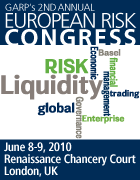On the panel: Howard K. Gruenspecht, EIA (moderating); David M. Arseneau, Federal Reserve Board; Guy F. Caruso, Center for Strategic and International Studies; Christopher Ellsworth, FERC; and Edward L. Morse, Credit Suisse.
By the way, massive global audience, I heard that all the presentations from EIA’s 2010 conference will be put on their website, so check there in the near future if you want to learn the details of all presentations.
So, what’s driving short-term energy prices these days? Well, I’ll give you a hint: it ain’t necessarily the fundamentals anymore.
Here are some highlights:
Arseneau went to bat first: Speaking on drivers for short-term energy prices, the man from the Fed wants to remind us that volatility, for them, has an impact on inflation and policy making. Arseneau is looking at a basic (stress: basic) framework consisting of two parts, fundamentals versus speculation.
There’s uncertainty in commodity markets, Arseneau states without irony [this coming from a regulatory body!]. Specifically in three areas: modeling, parameters, and understandings of the true state of the market. His solution? Research. Comprehensive research, in his view, will help reduce volatility ex ante (before) volatility strikes (versus conduct research ex post—after—volatility cycles). It is time to push “research frontiers.”
Morse was up next. For him, there are two clear factors leading to volatility: supply constraints/shortages (lead to price spikes) and algorithmic traders. Hmmm…
Morse also points to investment cycles, and the problems they create. For instance, refineries take time to build, a five-year lead time in general. By the time infrastructure can catch up with demand, the latter may fall (by, say, 10-12%), which then leads to a glut of capacity, which effects pricing, and on and on…
Caruso says that despite excess spare capacity, reduced demand and increased OPEC production volumes, high prices persist. Why? All of the following are contributive drivers:
• Insufficient data (from China, non-OECD countries)
• Misplaced confidence in OPEC quota compliance
• Premature, bullish market predictions
• Fears of long-term capacity constraints
• Investor moves back to commodities
• The declining dollar
• The adjustments made for “real” replacement prices for oil
In other words, are there new fundamentals at work?
Batting cleanup, Ellsworth of FERC, who, in referring to the 2008 State of the Market Report, discussed natural gas price-drivers. Ellsworth traditionally takes a look at physical elements, such as weather, storage, and pipeline flows, and also the effects of shale gas drilling. In 2008, however, non-physical fundamentals seemed to drive prices. For instance, during 2008 supply and use of natural gas grew at four percent each, yet prices in July skyrocketed to $13 mmBtu, with attendant physical events apparent as a driving force behind the increase. Why?
Well, Ellsworth says, financials were driving fundamentals. An influx of institutional investors (e.g. pension funds), for example, contributed to the jump. Likewise, the natural gas prices seemed to follow NYMEX futures.
*
That’s that for the Drivers session. Food for thought: are there new fundamentals at work in energy markets? And if so, have they moved from the physical side (e.g. storage capacity) to the financial side (e.g. institutional investing)? Discuss…






0 comments:
Post a Comment